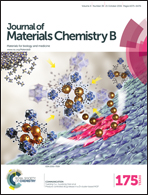Cellulosic micelles as nanocapsules of liposoluble CdSe/ZnS quantum dots for bioimaging†
Abstract
Nanostructures encapsulating multiple quantum dots (QDs) are of special interests for live cell imaging and biomolecular recognition due to their inherent signal amplification. In this study, a novel type of biomass-based nanomicelles was prepared and characterized for facile loading and solubilization of fluorescent hydrophobic CdSe/ZnS QDs in water. The biobased nanomicelles were formed by the self-assembly of amphiphilic cellulose-graft-poly (p-dioxanone) (MCC-g-PPDO) synthesized via homogeneous ring-opening polymerization in an ionic liquid. Through a simple physical loading method, multiple lipophilic CdSe/ZnS QDs can be simultaneously encapsulated in one MCC-g-PPDO micelle showing an obviously enlarged micelle size, whereas the loaded QDs exhibited a negligible change in their size and size distribution. The QDs-loaded cellulosic micelles exhibited good optical stability, narrow emission bandwidth as well as an acceptable quantum yield of ∼27%. Successful tumor cell internalization and negligible cytotoxicity were observed with these light-emitting cellulosic micelles. It was found that over 90% of the cells were viable after 24 h of exposure and the fluorescent signal inside the cells reached a maximum after 2 h of exposure. These QDs-loaded cellulosic nanomicelles derived from biomass are a promising candidate for bioimaging or other functional applications.


 Please wait while we load your content...
Please wait while we load your content...